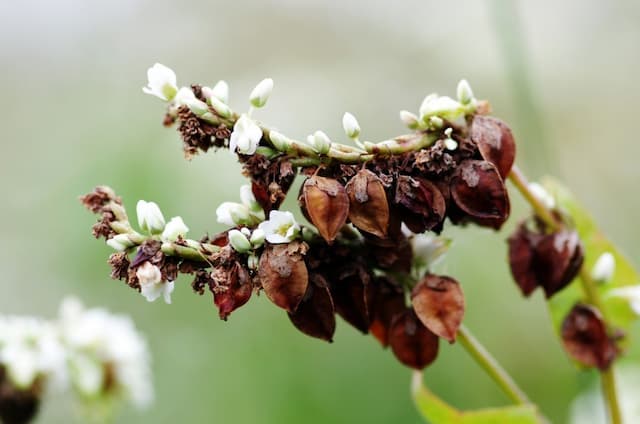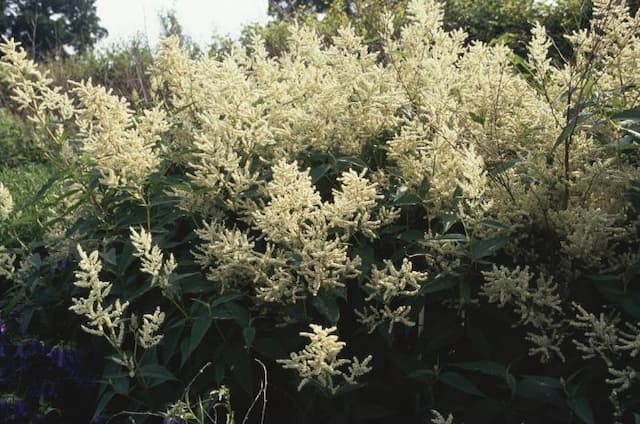Russian vine Fallopia baldschuanica
ABOUT
Fallopia baldschuanica, commonly known as Russian vine or mile-a-minute vine, is a vigorous climbing plant known for its fast growth rate and dense foliage. The appearance of Russian vine is characterized by twining stems that are capable of covering existing structures or plants. Its leaves are heart-shaped to triangular, with a bright green color that provides a lush backdrop for other plantings. During the blooming season, Russian vine produces small, white or pale pink flowers that are arranged in panicles. These delicate, frothy blooms add a soft and decorative element to the plant. The flowers eventually give way to small, winged fruits that are typically not highly ornamental. The stems of the Russian vine are thin and flexible, allowing them to wrap around supports and other plants as the vine grows. This habit makes it particularly useful for covering trellises, fences, and arbors, as it can create a green screen or privacy barrier in a relatively short period. However, due to its vigorous growth, Russian vine can become invasive if not managed properly, overrunning other plants and structures. Its visual appeal also changes with the seasons. In the autumn, the foliage can turn a yellowish color, providing a different visual interest as the growing season comes to an end. Despite the lack of details on its size, it's clear that the Russian vine's appearance is both attractive and potentially dominant in any garden setting where it's allowed to grow unchecked.
About this plant
 Names
NamesFamily
Polygonaceae
Synonyms
Russian Vine, Bukhara Fleeceflower, Chinese Fleece Vine, Silver Lace Vine
Common names
Polygonum baldschuanicum, Bilderdykia baldschuanica, Reynoutria baldschuanica, Fallopia aubertii.
 Toxicity
ToxicityTo humans
Russian vine, commonly known as Fallopia baldschuanica, is not well-known for being toxic to humans. There are no significant reports of poisoning or adverse health effects from ingesting or handling this plant. As with any plant, individual allergies or sensitivities could potentially cause mild discomfort or reactions, but generally, Russian vine is not considered a poisonous plant to people.
To pets
Russian vine, also called Fallopia baldschuanica, does not carry a reputation for being highly toxic to pets. There is limited information regarding its toxicity in domestic animals such as dogs and cats, but it is generally not listed among the commonly known toxic plants for pets. Owners should still exercise caution and prevent pets from excessive ingestion of any non-food plants, as they may cause gastrointestinal upset or an allergic reaction in some cases.
 Characteristics
CharacteristicsLife cycle
Perennials
Foliage type
Deciduous
Color of leaves
Green
Flower color
White
Height
20 feet (6 meters)
Spread
20 feet (6 meters)
Plant type
Climber
Hardiness zones
5
Native area
Central Asia
Benefits
 General Benefits
General Benefits- Ornamental value: Adds visual appeal to gardens with its lush, rapidly growing vines and white to pinkish flower clusters.
- Fast growth: It can quickly cover fences, arbors, and walls, providing a green facade or natural privacy screen.
- Erosion control: Its dense foliage and robust growth habit can help stabilize soil on slopes and prevent erosion.
- Wildlife support: It offers food in the form of nectar to beneficial insects like bees and butterflies.
- Shade provider: Its dense growth can create shaded areas in the garden which can reduce local temperatures.
- Drought tolerance: Once established, it's relatively drought-tolerant, requiring little water.
- Low maintenance: It requires minimal care beyond trimming to keep it under control, making it suitable for low-maintenance landscapes.
 Medical Properties
Medical PropertiesThis plant is not used for medical purposes.
 Air-purifying Qualities
Air-purifying QualitiesThis plant is not specifically known for air purifying qualities.
 Other Uses
Other Uses- Fallopia baldschuanica, commonly known as Russian Vine, can be used as a natural screen or privacy barrier due to its dense and rapid growth.
- In garden design, Russian Vine can be employed to quickly cover unsightly features like old fences or sheds.
- This plant can be used in erosion control, as its dense root system helps to stabilize soil on slopes or banks.
- With its ability to grow in tough conditions, Russian Vine can be used for reclaiming derelict industrial sites by greening and binding the soil.
- Russian Vine's vigorous growth can provide quick shade in outdoor seating areas or over pergolas in a relatively short period.
- The plant can be used in noise reduction barriers for gardens adjacent to busy roads, as its thick foliage dampens sound.
- The robustness of Russian Vine makes it suitable for coastal areas, where it can act as a windbreak to protect more delicate plants.
- When controlled, it can be used in large-scale topiary projects for an immediate impact due to its fast growth.
- Its dense covering ability allows Russian Vine to be used in avian habitat restoration projects as it provides shelter for birds quickly.
- In permaculture systems, the Russian Vine can be used as a 'chop and drop' mulch to build soil fertility over time.
Interesting Facts
 Feng Shui
Feng ShuiThe Russian Vine is not used in Feng Shui practice.
 Zodiac Sign Compitability
Zodiac Sign CompitabilityThe Russian Vine is not used in astrology practice.
 Plant Symbolism
Plant Symbolism- Invasiveness: Also known as Russian vine, Fallopia baldschuanica is often used to symbolize the idea of invasiveness or aggressive expansion, as it is a plant known for its rapid growth and ability to overwhelm other plants and structures in its vicinity.
- Perseverance: The plant can also symbolize perseverance or determination due to its robust nature and ability to thrive in a variety of conditions, often overcoming obstacles in its path.
- Adaptability: Russian vine may represent adaptability, reflecting its capacity to adapt to diverse environments and its resilience in facing challenges.
- Connection: The way that the vine grows and twines around structures and other plants might symbolize connection and interdependence between different entities, illustrating the idea that relationships are complex and intertwined.
- Envelopment: The dense foliage and the way it covers surfaces can symbolize envelopment, protection, or concealment, indicating a desire to either protect, hide away, or keep something from being exposed.
 Water
WaterSilverlace vine requires regular watering to establish a deep root system, especially during its first growing season. Once established, it is quite drought-tolerant but benefits from additional water during prolonged dry spells. Water the plant thoroughly, ensuring the soil becomes moist but not waterlogged. Aim for about 1 inch of water per week, which equates to roughly 0.6 gallons per week for a small vine. During hot and dry periods, increase the frequency of watering to prevent stress.
 Light
LightSilverlace vine thrives in full sun to partial shade conditions. The ideal spot for this plant is an area where it receives at least 6 hours of direct sunlight daily. Although it can tolerate some shade, too much can lead to reduced flowering and a less vigorous plant. This fast-growing vine performs best when it can soak up the sun's rays, encouraging lush foliage and an abundance of flowers.
 Temperature
TemperatureSilverlace vine is hardy and can tolerate a range of temperatures, prospering in USDA hardiness zones 4 through 8. It can survive minimum temperatures as low as -30°F and is comfortable in maximum summer temperatures of around 90°F. The ideal temperature range for vigorous growth is between 60°F and 80°F.
 Pruning
PruningSilverlace vine should be pruned to control its growth, encourage air circulation, and maintain a desirable shape. Pruning is best done in late winter or early spring before new growth begins. Cut back any dead or damaged branches, and thin out any overcrowded areas. This vigorous climber can be pruned back severely if necessary since it can recover quickly and will produce blooms on new growth.
 Cleaning
CleaningAs needed
 Soil
SoilRussian Vine prefers well-drained soil with a pH range of 5.5 to 7.0. The best soil mix should include a combination of garden soil, compost, and river sand to improve drainage and fertility. Incorporate organic matter to ensure adequate nutrients for growth.
 Repotting
RepottingRussian Vine is a vigorous grower but doesn't need frequent repotting. It should be repotted every few years or when it has outgrown its current container. Overwintering structures such as tubers or rhizomes should be inspected annually.
 Humidity & Misting
Humidity & MistingRussian Vine tolerates a wide range of humidity levels but thrives best in moderate conditions. It is quite adaptable and does not require specific humidity adjustments in most environments.
 Suitable locations
Suitable locationsIndoor
Place in bright, indirect light and prune to manage growth.
Outdoor
Provide support for climbing, full sun to partial shade.
Hardiness zone
4-8 USDA
 Life cycle
Life cycleFallopia baldschuanica, commonly known as Russian Vine or Mile-a-Minute, begins its life cycle as a seed that germinates in moist soil in spring. Its roots quickly establish in the ground, and shoots emerge, which rapidly grow into long, twining stems capable of covering structures and outcompeting nearby plants. Throughout the summer, the plant produces small white or greenish-white flowers in panicles, which mature into winged fruits that are dispersed by wind, aiding in its invasive spread. The plant is a perennial, so in autumn, its leaves will die back to the ground while the robust root system survives the winter. In the following spring, new growth will sprout from the roots, repeating the cycle and allowing the plant to expand its territory further. Russian Vine can also reproduce vegetatively through root fragments, making its control particularly challenging.
 Propogation
PropogationPropogation time
Spring to Summer
Russian vine, scientifically known as Fallopia baldschuanica, is best propagated through cuttings, a process that can be done in late spring through summer. To propagate by cuttings, select a healthy, vigorous shoot and cut a piece of stem about 6 to 8 inches (15 to 20 centimeters) long with several leaves. Remove the lower leaves, leaving a few at the top, and dip the cut end into a rooting hormone powder to enhance root growth. Plant the cutting in a pot filled with a well-draining potting mix, ensuring at least one leaf node (where leaves are attached) is buried as this is where roots will develop. Water the cutting and place it in a warm spot with indirect light. Keep the soil moist but not waterlogged. Roots should form in a few weeks, after which the cutting can gradually acclimate to outdoor conditions before being transplanted to its final location.







![Red bistort [JS Seven Oaks Village]](/_next/image?url=https%3A%2F%2Fplants-admin.emdemapps.com%2Fimages%2Fplants%2F%2Fimages%2F604b56557c0e3.png&w=640&q=75)

